Step 1: Add A New Blank Layer
With the photo newly opened in Photoshop, we can see in the Layers palette that we currently have one layer, the Background layer, which is the layer our image is sitting on: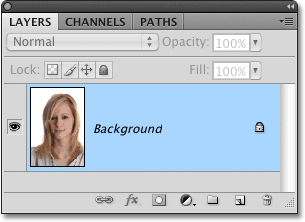
The Background layer contains the original image.
Even though our goal is to make the original photo look better, we
still want to protect the original image, so let’s add a new blank layer
above the Background layer. We’ll do all of our spot healing work on
this separate layer. Click on the New Layer icon at the bottom of the Layers palette:
Add a new layer by clicking on the New Layer icon.
Step 2: Rename The New Layer
Photoshop adds the new blank layer above the Background layer, but by default, it names the layer “Layer 1″. That doesn’t tell us much about what the layer is being used for, so double-click directly on the layer’s name in the Layers palette and rename it spot healing. It’s not uncommon when retouching images to end up with lots of layers, and giving each one a descriptive name makes it easier to keep them organized. Press Enter (Win) / Return (Mac) when you’re done to accept the new name: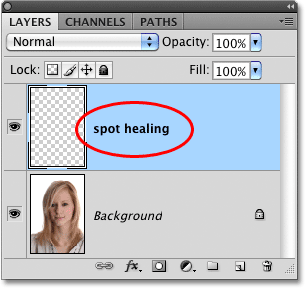
Rename the new layer “spot healing”.
Step 3: Select The Spot Healing Brush
Select the Spot Healing Brush from the Tools palette. You’ll find it grouped in with the other healing tools. If one of the other tools is showing in place of the Spot Healing Brush, click on the tool and hold your mouse button down for a second or two until a small fly-out menu appears, then select the Spot Healing Brush from the menu: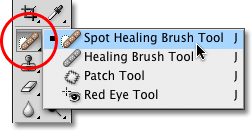
The Spot Healing Brush is grouped in with the other healing tools.
Step 4: Select The “Sample All Layers” Option
By default, the Spot Healing Brush works only with the layer that’s currently selected in the Layers palette, which will cause us some problems if we try to use it right now since we have a blank layer selected, which means that all we’d be able to do is replace nothing with different nothing. We need to tell Photoshop to look at the image on the Background layer as well. To do that, select the Sample All Layers option in the Options Bar along the top of the screen:
Make sure “Sample All Layers” is selected in the Options Bar.
Step 5: Click On The Problem Spots To Heal Them
With the Spot Healing Brush and the Sample All Layers option selected, all we need to do now is click on problem areas in the image to fix them! I’ll zoom in on an area of the girl’s face so I can see the problem spots more clearly, then I’ll move my brush cursor over one of the pimples and adjust my brush size with the left or right bracket key so it’s just slightly larger than the pimple itself: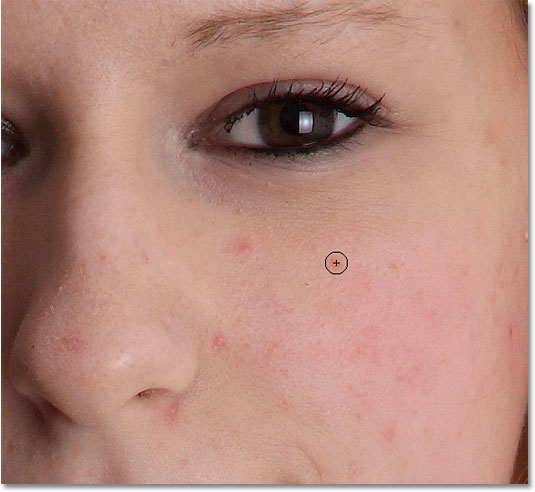
Use the keyboard shortcut to make the brush cursor a bit larger than the problem spot.
I’ll click on the pimple with the Spot Healing Brush, and just like
that, it’s gone, replaced with good texture from somewhere in the
surrounding area: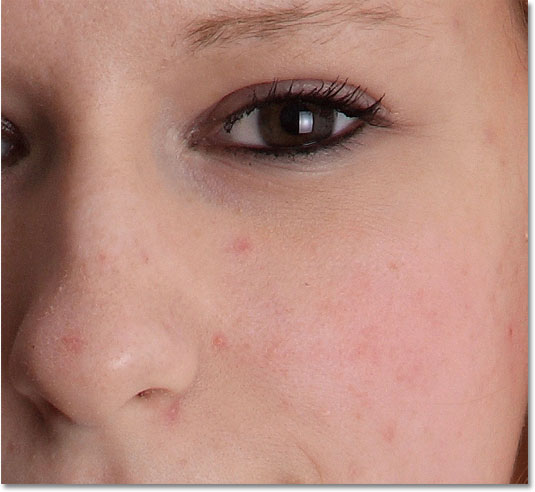
One click is all it took to remove the pimple.
As I mentioned earlier, sometimes the Spot Healing Brush can make a mistake, so if that happens, just press Ctrl+Z (Win) / Command+Z
(Mac) to undo it and try again. Each time you try again, you’ll get a
different, random result. I’ll continue clearing up other pimples in
the area by moving my brush over them, adjusting its size with the left
or right bracket key, and clicking: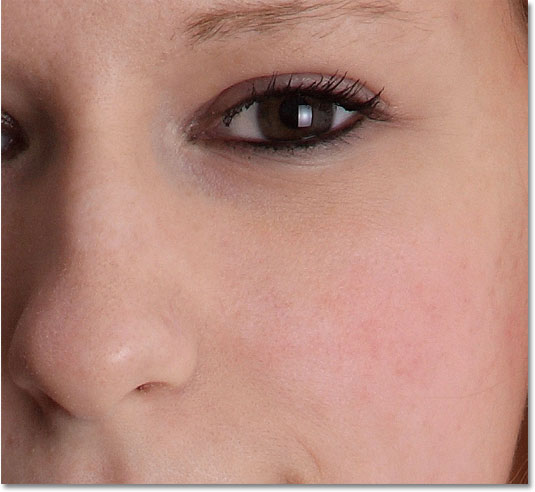
Pimples? What pimples?
For problem areas that don’t fit easily into the round shape of the
brush cursor, like small scratches or oddly-shaped skin blemishes,
simply click and drag over them, again keeping the brush as small as
possible. Here, we see a longer, narrow row of pimples just below the
corner of the girl’s mouth: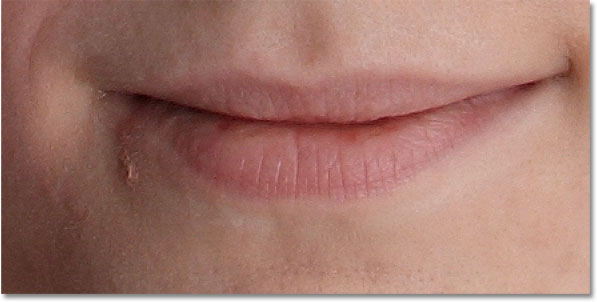
Not all problem areas can fit inside the round brush cursor.
To heal this area, I’ll click and drag a short stroke over it,
starting just below the pimples and moving upward. As you drag, it will
look as if you’re painting over the area with black. The color is only
temporary so you can see the area you’ve covered: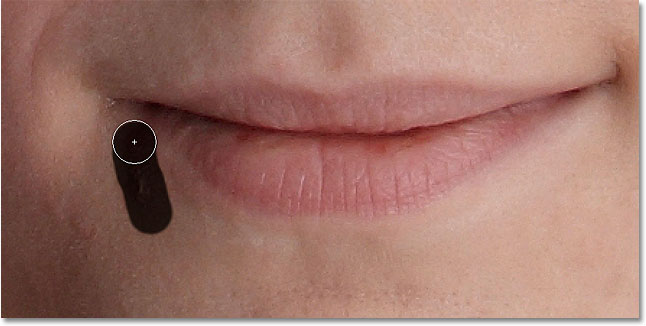
Dragging with the Spot Healing Brush looks like we’re painting with black.
When you release your mouse button, the black color disappears and the area is healed: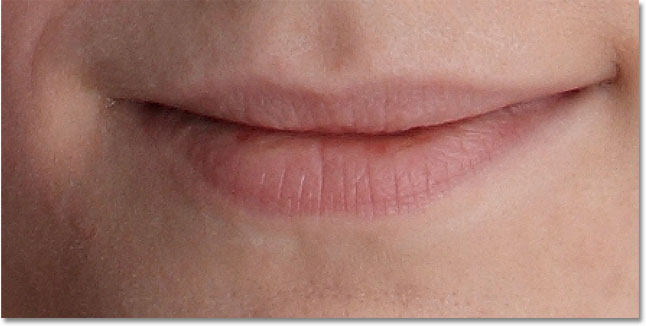
For best results, use short brush strokes when you need to click and drag across an area.
The direction you drag in can make a big difference in the results
because Photoshop favors the area you started dragging from when it
looks for replacement texture. If you can’t seem to get the Spot Healing
Brush to work no matter how many times you drag over the problem, try
dragging from a different direction, and whenever possible, begin
dragging from the cleanest area with the largest amount of useable image
data.The Brush Modes
If you’re using the Spot Healing Brush to remove acne or other skin problems as I am here, you’ll often get even better results by changing the Brush Mode in the Options Bar from Normal (the default setting) to Lighten:

Try the Lighten brush mode when fixing skin problems.
With the brush mode set to Lighten, Photoshop will only replace
pixels that are darker than the good texture data. Since pimples and
other skin blemishes are usually darker than normal skin tone, only the
pimple or blemish itself gets replaced, leaving more of the original
image surrounding it intact. If a blemish happens to be lighter than the
normal skin tone, use the Darken mode. You can quickly switch between all of the brush modes for the Spot Healing Brush from your keyboard by holding down the Shift key and pressing the + or - keys.Proximity Match and Create Texture
Directly to the right of the brush mode in the Options Bar are two additional options, Proximity Match and Create Texture. Proximity Match is the default setting and with it selected, Photoshop looks for good image data surrounding the problem area you’ve clicked on and randomly selects texture from the good area to replace the bad texture with. Sometimes though, there simply isn’t enough good image data to use and no matter how many times you try, the Spot Healing Brush fails miserably. When you find yourself in this situation, try selecting the Create Texture option. Photoshop will examine the surrounding area and create its own texture based on what it thinks the good texture should look like.

When there isn’t enough good image data for Proximity Match to work, try the Create Texture option.
I’ll continue clicking around the image to remove the remaining pimples. Here, once again, is how the photo looked originally:
The original untouched image.
And here’s how it looks after quickly retouching it with the Spot Healing Brush: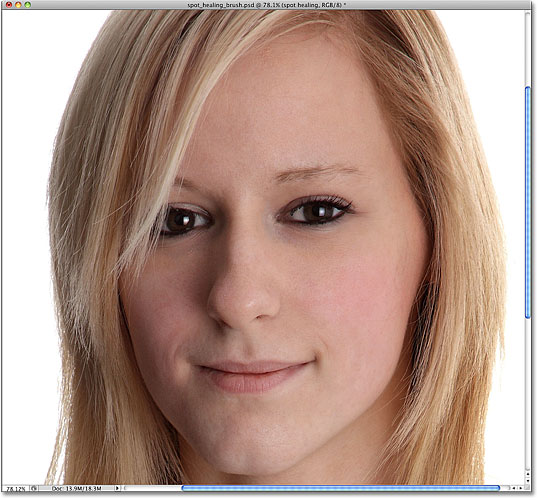
Removing Acne, Skin Blemishes >>>>> Download Now
ReplyDelete>>>>> Download Full
Removing Acne, Skin Blemishes >>>>> Download LINK
>>>>> Download Now
Removing Acne, Skin Blemishes >>>>> Download Full
>>>>> Download LINK g7